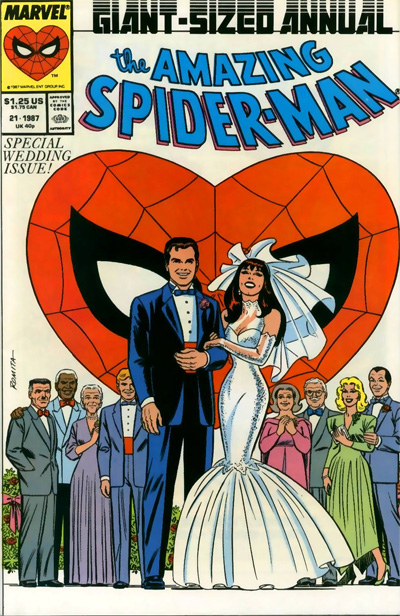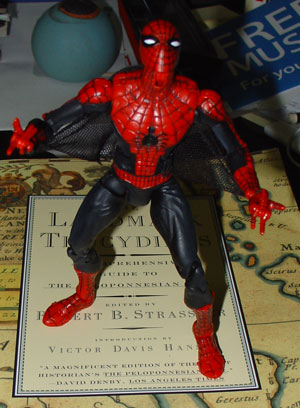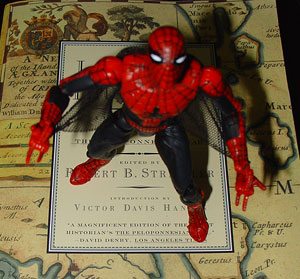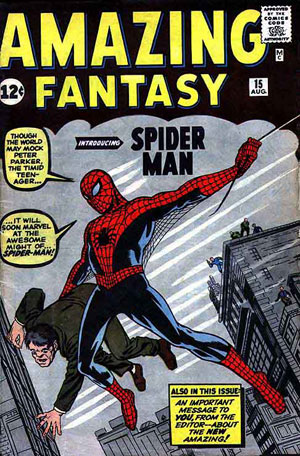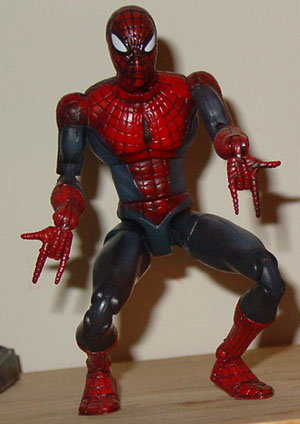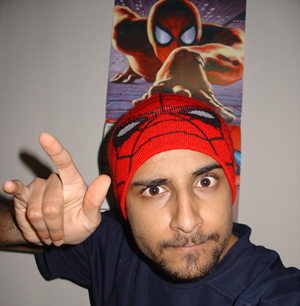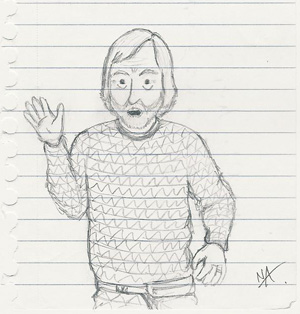 As the worldwide furor over the Danish newspaper Jyllands-Posten’s Muhammad cartoons grows, with Muslims boycotting Danish products and even certain people in Syria torching embassies, many in Canada are probably wondering what the controversy is all about.
As the worldwide furor over the Danish newspaper Jyllands-Posten’s Muhammad cartoons grows, with Muslims boycotting Danish products and even certain people in Syria torching embassies, many in Canada are probably wondering what the controversy is all about.
Danish writer KÃ¥re Bluitgen complained of the difficulty of finding an illustrator willing to draw Muhammad for a book he was writing on the Qur’an and Muhammad. In September of 2005, as part of a “discussion” on the freedom of speech and self-censorship with regards specifically to depicting Muhammad, Jyllands-Posten commissioned twelve artists to draw Muhammad.
Many strains — and certainly the mainstream strains — of Islam forbid depictions of God, Muhammad, and other prophets. This is, in part, to prevent the worship of images. Most Muslim art from days back that has waded into depicting Muhammad usually obscures his face with light. In 1976, Moustapha Akkad produced and directed a film about the beginnings of Islam — “The Message.” The epic film masterfully portrays the early rise of Islam, all without ever once showing Muhammad on screen. Recently, several Muslims protested Time and Newsweek magazines’ depictions of Muhammad. The magazines subsequently apologized.
Muslims typically do not respond to depictions of Moses, Jesus and other prophets — who are prophets of Islam. Many watch the Ten Commandments, many others have seen the Passion of the Christ. There are also several depictions and representations of Muhammad all over the place, spanning several centuries. Many have been done by Muslims. Sometimes such depictions are very visible, but rarely elicit such a response. Why?
Much of the reporting on the cartoons simplifies the matter — the implication being that hordes of uncivilized and ultra-fundamentalist Muslims are reacting wildly to simple portrayals of Muhammad. However, the images published by Jyllands-Posten go far beyond simply depicting Muhammad — and very little reporting has actually described the pictures themselves. Many of them are disgustingly racist and stereotypical. Some of the artists who submitted cartoons decried the provocative nature of the assignment.
Here is a summary of the twelve drawings:
Kurt Westergaard‘s drawing is perhaps the one that has been seen by most people. It depicts Muhammad with bushy, eyebrows and a bushy but close-cropped beard. His angry eyes have dark circles underneath. His turban, with “There is no god but Allah, and Muhammad is his messenger,” inscribed on it in Arabic calligraphy is actually a bomb ready to explode.
Jens Julius Hansen‘s drawing has an Irani mullah-looking Muhammad standing in heaven in front of a presumably endless line of suicide bombers. “Stop, stop,” he implores, “We have run out of virgins!”
Franz Füchsel depicts Muhammad inside an ornate palace, wearing a green robe and looking at a drawing of himself. He is telling two charging angry Muslims with swords and bombs and guns to “Relax guys, it’s just a drawing made by some infidel from nowhere.”
Arne Sørensen shows a nervous cartoonist leaning over his drawing board and looking over his shoulder. He is drawing Muhammad — wearing a keffiyeh and sporting a hooked nose and almost bulging eyes.
Annette Carlsen‘s drawing featuers a line-up of seven people. All wearing turbans that look more Sikh than middle-eastern. It is hard to tell who is who in the line-up, although a a hippie and a woman (the two on the left) are clearly identifiable, as is KÃ¥re Bluitgen on the right. He is holding a sign that says, “KÃ¥re’s public relations, call and get an offer.” A man assessing the line-up says, “Hmm, I can’t recognize him.”
Erik Abild Sørensen shows five symbols that are presumably burqa-clad women, with Stars of David as eyes and Crescents as mouths. A caption says something like, “Prophet you crazy bloke! Keeping women under yoke” or “Prophet! Daft and dumb, keeping women under thumb.”
Rasmus Sand Høyer draws Muhammad with a turban, and a tunic with a shawl draped over one shoulder. He is holding a scimitar and has another one hanging off a belt going from shoulder to hip. He’s got a long frazzled beard with similar eyebrows. His eyes are obscured by a black bar. Flanking him on either side are two women in black abayas that obscure everything but the eyes. Their eyes are wide open, as in an expression of surprise.
Claus Seidel shows Muhammad wearing an orange turban, a white tunic, and white pants extending to the shins, as well as slippers. He is holding a stick in one hand, and with the other hand he leads a donkey loaded with stuff.
Poul Erik Poulsen has Muhammad wearing a turban, a tunic and pants that go down to the ankles, as well as slippers. However, his hands are held together and the tunic’s sleeves obscure both his hands. He has a brown beard. Around his head is a supposed halo. It is a yellow crescent going around and behind his head so that it looks like he has two horns coming out.
Peder Bundgaard draws a stylized Muhammad’s face integrated with a green crescent and star. The crescent cradles Muhammad’s face, and the right eye is a star. He has a turban and quite a hooked nose.
Bob Katzennelson draws KÃ¥re Bluitgen wearing a turban. An orange falls on his head and on the orange it says “PR-stunt.” Bluitgen is holding a stick figure drawing of Muhammad.
Lars Refn draws a young boy named Mohammed using a pointer to highlight a statement written in Farsi on a blackboard. It translates as something like “Jylland-Posten’s journalists are a bunch of reactionary provocateurs.”
I’m not going to bother, right now, with an actual analysis of the images. I’ll leave that up to you.
Most are presenting this as a bipolar issue. On one side are the defenders of the freedom of speech who argue that anything goes. On the other side are Muslims who argue that any depiction of Muhammad is blasphemy.
Water that polarity down a little and you get one one side people who admit that the images may have been offensive, but nevertheless defend the freedom of expression. On the other side are Muslims and progressives who agree that freedom of expression is very important but has its limits when it is likely to stoke such strong passions.
Free criticism of Muhammad and Islam is very important, just as criticism of Jesus and Christianity is important. If a religion is, indeed, the truth then it should be able to stand up to the criticism and if these men are indeed flawless messengers of God then their behaviour should stand to criticism as well. Muslims should be willing to receive and respond to such criticism, rationally and reasonably. This doesn’t always happen. Very often Muslims simply respond with attempts to shut down public discourse.
What’s also true is that recently there has been a hegemonizing and ossification of Islamic opinion. Whereas in the past depictions or at least modified depictions of Muhammad were permitted, recently the flexibility inherent in Islamic tradition has become rigid and has tilted toward absolute prohibition of such depictions. (However, this prohibition is not without basis in Islamic scripture and history. Muhammad is said to have taken out pictures of Jesus from the Ka’bah and to have destroyed them as well as other idols.)
At the same time, it’s not simply a matter of Muslims silencing any criticism of Muhammad. It has to be accepted that Muslims have a deep reverence and respect for Muhammad, above and beyond all other prophets. Popular depictions of Jesus and Moses don’t arouse Muslim passions. No Muslim burned copies of the Da Vinci Code, despite its tremendously blasphemous depiction of Jesus. Many countries have laws that prohibit the use of freedom of expression in such a way that may incite violence or be construed as a hate crime. The blatant and shameful racism and insensitivity shown in many of the above cartoons was simply a provocative action on the part of Jyllands-Posten. Hiding behind freedom of expression is a convenient defense, but it’s hard to believe that this is really what it was about in the first place.
It’s great to see the Muslim grassroots sticking it to Danish and other corporations by boycotting their products. It’s not that great to see them burning embassies and kidnapping foreigners. Somewhere along the line, though, they have to be able to distinguish between a newspaper in Denmark, its government, and its corporations.
There are plenty of problems in the Muslim world, many of these problems are a consequence of Muslim ignorance coupled with foreign interference. The links are clear. Why not channel such efforts toward ameliorating those conditions? Boycott American products, and maybe they’ll stop propping up the dictators. Stop buying SUVs, start buying Japanese hybrids. Why not use this anger to burn government buildings, where corrupt dictators have been picking off billions and billions that should have been going to the people of those countries? Why not protest racism and blatant xenophobia in the Arab world?
As for the Europeans and North Americans, it’s great to pretend to be defenders of rights and freedoms, while actively and covertly denying the majority of the world their rights and freedoms. That’s all that needs to be said on that matter.

